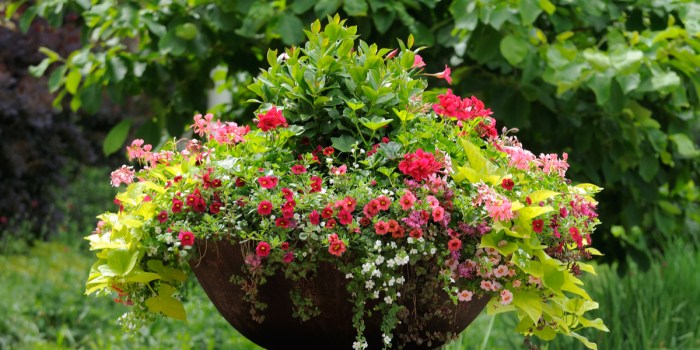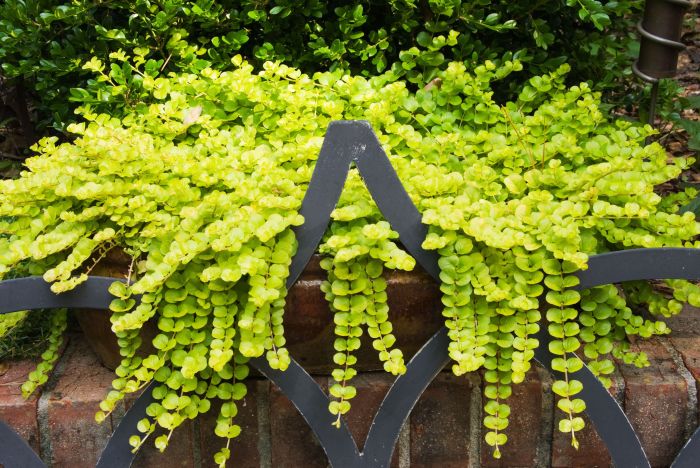Embrace the allure of trailing plants, enchanting botanical wonders that cascade with elegance and grace. These versatile plants not only beautify your surroundings but also offer a wealth of benefits, transforming your living spaces into tranquil havens.
From their aesthetic charm to their therapeutic qualities, trailing plants have much to offer. Their cascading foliage adds visual interest and movement, creating a sense of depth and ambiance. Beyond their aesthetic appeal, they also serve as natural air purifiers, improving indoor air quality.
Types of Trailing Plants
Trailing plants, characterized by their long, cascading stems, add a touch of elegance and drama to any indoor or outdoor space. These versatile plants come in a wide variety of shapes, sizes, and colors, offering a diverse selection to suit any taste or environment.
Growth Habits and Characteristics
Trailing plants exhibit a range of growth habits, including:
- Vining:Plants with twining stems that climb or hang down, such as pothos and ivy.
- Cascading:Plants with long, flowing stems that hang over the edges of containers or baskets, such as spider plants and maidenhair ferns.
- Trailing:Plants with stems that creep along the ground or other surfaces, such as creeping Jenny and vinca.
The leaves of trailing plants vary greatly in shape, size, and texture. Some, like the heart-shaped leaves of pothos, are broad and flat, while others, like the needle-like leaves of asparagus fern, are narrow and pointed. The colors range from deep greens to variegated shades of white, cream, and yellow.
Ideal Growing Conditions
The ideal growing conditions for trailing plants vary depending on the species. However, most prefer:
- Light:Bright, indirect light is ideal for most trailing plants. Avoid placing them in direct sunlight, as this can scorch their leaves.
- Water:Water trailing plants regularly, allowing the soil to dry out slightly between waterings. Overwatering can lead to root rot.
- Soil:Well-draining soil is essential for trailing plants. A potting mix specifically designed for indoor plants is a good choice.
With proper care, trailing plants can thrive for many years, adding beauty and elegance to any indoor or outdoor space.
Benefits of Trailing Plants

Trailing plants are not only visually appealing but also offer a range of practical and therapeutic benefits.Aesthetically, trailing plants can add visual interest and movement to a space. Their cascading foliage creates a sense of drama and can draw the eye to specific areas.
They can also be used to soften the edges of furniture or to create a more organic feel in a room.Practically, trailing plants can help to purify the air by removing toxins. They can also provide privacy by screening off windows or doorways.
Trailing plants are a beautiful way to add greenery to your home. They can be hung from baskets, shelves, or even the ceiling. For more information on hanging plants, visit Hanging Plants Indoor . Trailing plants are a great way to add a touch of nature to your home, and they can also help to purify the air.
Additionally, their trailing foliage can help to absorb sound, making them ideal for use in noisy environments.Therapeutically, trailing plants have been shown to reduce stress and promote relaxation. Their gentle movement and lush greenery can create a calming atmosphere. Additionally, the act of caring for plants can be therapeutic in itself.
Uses of Trailing Plants
Trailing plants, with their graceful stems and cascading foliage, offer a versatile range of uses in both indoor and outdoor settings, adding beauty and functionality to any space.
Indoors, trailing plants thrive in hanging baskets, bringing a touch of greenery to high spaces. They also excel in window boxes, creating a vibrant display that frames windows and brings the outdoors in. For vertical gardening, trailing plants can be trained to climb trellises or walls, creating a lush and space-saving display.
Outdoors
Outdoors, trailing plants serve various purposes. As groundcovers, they create a lush carpet that suppresses weeds and adds color to bare areas. Along borders, they spill over edges, softening the landscape and creating a cascading effect. Vertical gardens, utilizing trellises or walls, allow trailing plants to climb upwards, maximizing vertical space and creating a stunning display.
Special Occasions
Trailing plants also play a significant role in special occasions. At weddings, they add a romantic touch to archways and bouquets. For events, they can be used to create eye-catching centerpieces or decorate stages, bringing a touch of nature and elegance to any celebration.
Care and Maintenance of Trailing Plants

Trailing plants, with their graceful cascading foliage, bring a touch of elegance to any space. To keep these plants thriving, proper care and maintenance are essential. Regular watering, fertilizing, and pruning ensure optimal growth and prevent common problems.
Watering
Trailing plants have moderate water needs and prefer well-draining soil. Allow the soil to dry out slightly between waterings to prevent overwatering, which can lead to root rot. During hot, dry periods, increase watering frequency to keep the soil moist.
Fertilizing
Fertilize trailing plants monthly during the growing season with a balanced liquid fertilizer. Avoid overfertilizing, as it can burn the roots and stunt growth.
Pruning
Regular pruning is crucial for maintaining the shape and health of trailing plants. Trim back any dead or damaged leaves and stems. Pinching back the tips of growing stems encourages bushier growth.
Pest and Disease Control
Trailing plants are generally hardy, but they can be susceptible to pests such as aphids and mealybugs. Treat infestations promptly with insecticidal soap or neem oil. Monitor plants regularly for signs of disease, such as yellowing leaves or powdery mildew.
Address diseases by isolating affected plants and treating them with appropriate fungicides.
Nutrient Deficiencies
Nutrient deficiencies can manifest in trailing plants as discolored leaves or stunted growth. Nitrogen deficiency causes yellowing of leaves, while phosphorus deficiency results in stunted growth and poor flowering. If nutrient deficiencies are suspected, fertilize the plants with a balanced fertilizer or use a soil test to determine the specific nutrients needed.
Monitoring and Adjustment
Regular monitoring is key to the health of trailing plants. Observe the plants for any changes in appearance or growth patterns. Adjust watering, fertilizing, or pruning routines as needed based on the plant’s specific requirements. By providing appropriate care and maintenance, trailing plants can thrive and add beauty and elegance to any space.
Design Ideas with Trailing Plants
Trailing plants add a touch of elegance and greenery to any space. Whether you’re looking to create a lush indoor oasis or a vibrant outdoor sanctuary, trailing plants offer endless possibilities for design. Here are a few ideas to inspire your next project:
Living Rooms
Trailing plants can transform a living room into a cozy and inviting space. Hang them from the ceiling or place them on shelves or windowsills to create a cascading effect. Choose plants with long, flowing vines, such as pothos, ivy, or spider plants, to add movement and drama to the room.
Consider using a variety of colors and textures to create a visually appealing display.
Bedrooms
Trailing plants can bring a touch of tranquility to a bedroom. Place them on nightstands, dressers, or windowsills to create a calming atmosphere. Choose plants with soft, trailing leaves, such as ferns, maidenhair ferns, or string of pearls, to promote relaxation and sleep.
Consider using a combination of trailing and upright plants to create a layered look.
Patios, Trailing plants
Trailing plants can add a touch of greenery and privacy to a patio. Hang them from trellises or pergolas to create a shaded canopy, or place them in pots around the perimeter of the space to create a lush border.
Choose plants that are tolerant of sun and heat, such as lantana, bougainvillea, or jasmine, to create a vibrant outdoor oasis.
Tips for Selecting Trailing Plants
When selecting trailing plants for your design project, consider the following factors:
- Space:Choose plants that are appropriate for the size of your space. Smaller plants are suitable for shelves or windowsills, while larger plants can be used to create a dramatic statement.
- Light:Consider the amount of light available in the space where you plan to place the plants. Some trailing plants, such as pothos and ivy, can tolerate low light, while others, such as ferns and maidenhair ferns, prefer bright, indirect light.
- Style:Choose plants that complement the overall style of your space. For a modern look, opt for plants with clean lines and simple leaves, such as snake plants or ZZ plants. For a more traditional look, choose plants with flowing vines and delicate leaves, such as ivy or ferns.
Epilogue

Incorporating trailing plants into your decor is not merely a design choice; it’s an investment in beauty, well-being, and tranquility. Whether you seek to adorn your home, enhance your outdoor spaces, or create a captivating atmosphere for special occasions, trailing plants offer endless possibilities.
Embrace their versatility and transform your surroundings into an oasis of elegance and serenity.
Helpful Answers
What are the most popular types of trailing plants?
Some popular trailing plants include pothos, ivy, spider plants, and wandering Jew.
How often should I water trailing plants?
Water trailing plants when the top inch of soil feels dry to the touch.
Can trailing plants tolerate low light conditions?
Some trailing plants, such as pothos and snake plants, can tolerate low light conditions.